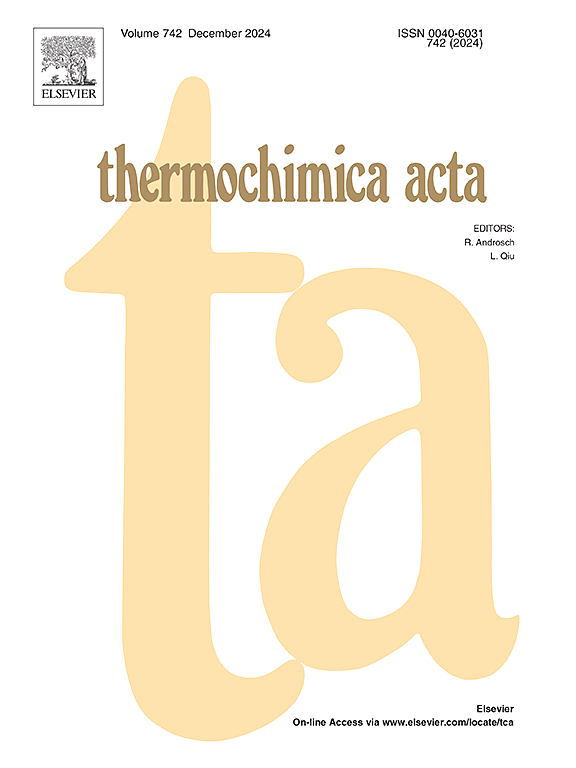用芳香族二胺固化的 Novolac 环氧树脂的可燃性
IF 3.1
2区 化学
Q2 CHEMISTRY, ANALYTICAL
引用次数: 0
摘要
研究了用有机磷化合物 9,10-二氢-9-氧杂-10-磷菲-10-氧化物(DOPO)对 Novolac 环氧树脂进行改性以降低易燃性及其对固化反应的影响。使用了三种芳香族二胺固化剂,即 4,4′-二氨基二苯甲烷(DDM)、4,4′-二氨基二苯砜(DDS)和二乙基甲苯二胺(DETDA)。固化树脂的热稳定性和动态机械性能取决于固化剂与 DOPO 的相互作用。起始降解温度随着磷含量的增加而降低,这表明 DOPO 对热稳定性有影响。DDM 3 %P 样品的玻璃化转变温度(Tg)最高,为 136 °C,而在所有样品中,DDS 交联模拟物的玻璃化转变温度(Tg)最高,为 147 °C。锥形量热仪结果表明,加入 DOPO 化合物后,Novolac 环氧树脂的着火反应有所改善,DDM 3 %P 的峰值放热率(pHRR)降低了 67%,总放热率(THR)降低了 53%。含有 DOPO 的改性样品具有自熄灭性能,达到了 UL-94 V-0 等级,DDM 3 %P 的极限氧指数(LOI)值最高达到 37.1%,与纯净的 Novolac 环氧树脂相比,火焰蔓延更小。本文章由计算机程序翻译,如有差异,请以英文原文为准。
Flammability of Novolac epoxy cured with aromatic diamines
The modification of Novolac epoxy with the organophosphorus compound 9,10-dihydro-9-oxa-10-phosphaphenanthren-10-oxide (DOPO) to reduce flammability and its influence on curing reactions has been investigated. Three aromatic diamine curing agents were used, namely 4,4′-diaminodiphenylmethane (DDM), 4,4′-diaminodiphenylsulphone (DDS), and diethyltoluenediamine (DETDA). The thermal stability and dynamic-mechanical behaviour of the cured resin depend on interactions of the curing agent with DOPO. The onset degradation temperature decreased with increasing phosphorus content, indicating the influence of DOPO on thermal stability. The DDM 3 %P sample exhibited the highest glass transition (Tg) of 136 °C, while DDS-crosslinked simples displayed the highest Tg of 147 °C among all samples. An improvement in the reaction of Novolac epoxy to fire was achieved by incorporating DOPO compound, as indicated by cone calorimetry results, showing up to a 67 % reduction in the peak heat release rate (pHRR) and 53 % reduction in total heat release (THR) for DDM 3 %P. The modified samples containing DOPO presented a self-extinguishing performance, displaying a UL-94 V-0 rating and a limiting oxygen index (LOI) values reached a maximum of 37.1 % for DDM 3 %P, with less flame propagation than for neat Novolac epoxy.
求助全文
通过发布文献求助,成功后即可免费获取论文全文。
去求助
来源期刊

Thermochimica Acta
化学-分析化学
CiteScore
6.50
自引率
8.60%
发文量
210
审稿时长
40 days
期刊介绍:
Thermochimica Acta publishes original research contributions covering all aspects of thermoanalytical and calorimetric methods and their application to experimental chemistry, physics, biology and engineering. The journal aims to span the whole range from fundamental research to practical application.
The journal focuses on the research that advances physical and analytical science of thermal phenomena. Therefore, the manuscripts are expected to provide important insights into the thermal phenomena studied or to propose significant improvements of analytical or computational techniques employed in thermal studies. Manuscripts that report the results of routine thermal measurements are not suitable for publication in Thermochimica Acta.
The journal particularly welcomes papers from newly emerging areas as well as from the traditional strength areas:
- New and improved instrumentation and methods
- Thermal properties and behavior of materials
- Kinetics of thermally stimulated processes
 求助内容:
求助内容: 应助结果提醒方式:
应助结果提醒方式:


